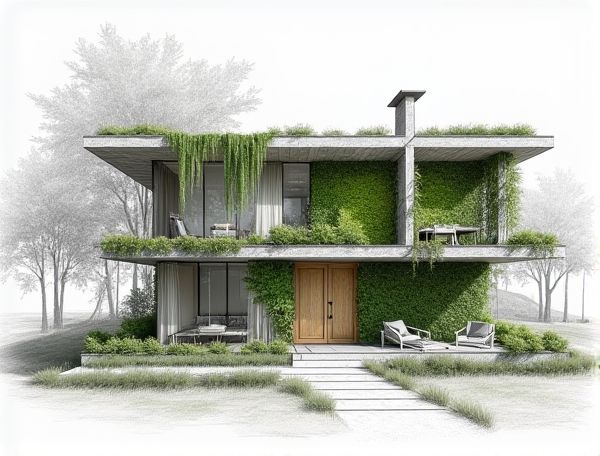
Photo illustration: Biophilic home design with active green walls
Incorporating biophilic home design with active green walls enhances air quality and creates a calming, natural ambiance that connects you with the outdoors. Discover how transforming your living space with these vibrant, living installations can improve well-being by reading more in the article.
Introduction to Biophilic Design Concepts
Biophilic design integrates natural elements into home environments to enhance occupant well-being and productivity. Core principles include maximizing natural light, incorporating indoor plants, and using organic materials such as wood and stone to create a connection with nature. Research shows that biophilic spaces reduce stress, improve air quality, and promote psychological health by fostering a sense of harmony between indoor and outdoor environments.
The Science Behind Active Green Walls
Active green walls use living plant systems integrated with advanced irrigation and airflow technologies to improve indoor air quality and regulate temperature. These green walls enhance your home's energy efficiency by naturally filtering pollutants and reducing the need for artificial cooling. Scientific studies show that the strategic placement of active green walls can significantly boost wellbeing by increasing oxygen levels and promoting a healthier living environment.
Key Benefits of Integrating Living Walls at Home
Integrating living walls at home enhances indoor air quality by naturally filtering pollutants and increasing oxygen levels, promoting a healthier living environment. These vertical gardens improve thermal insulation, leading to energy savings by regulating indoor temperatures and reducing the need for heating and cooling. Living walls also add aesthetic value and biophilic design elements, creating calming, nature-inspired spaces that boost mental well-being and overall comfort.
Essential Elements of Biophilic Home Design
Incorporating natural light, indoor plants, and organic materials like wood and stone enhances air quality and creates a calming atmosphere, crucial components of biophilic home design. Your space benefits from the integration of natural textures, water features, and views of nature, which promote well-being and reduce stress.
Choosing the Right Plants for Active Green Walls
Selecting resilient, low-maintenance plants like ferns, succulents, or pothos ensures your active green wall thrives with minimal care. Your choice should also consider light exposure and humidity to optimize plant health and longevity.
Installation Considerations for Residential Green Walls
Proper structural support and moisture barriers are essential for the successful installation of residential green walls to prevent damage to your home's interior. Selecting appropriate irrigation systems and ensuring easy access for maintenance enhances the longevity and health of the plants, optimizing the overall aesthetic and environmental benefits.
Maintenance Tips for Long-Lasting Living Walls
Regularly inspect living walls for pests and diseases to prevent damage and ensure healthy plant growth. Implement an efficient irrigation system with timers to maintain optimal moisture levels and reduce water waste.
Enhancing Indoor Air Quality with Biophilic Features
Incorporating biophilic features such as indoor plants, natural ventilation, and water elements significantly improves indoor air quality by reducing pollutants and increasing oxygen levels. Utilizing materials like natural wood and breathable fabrics further enhances air purification while creating a healthier, more harmonious living environment.
Combining Technology and Nature in Home Interiors
Integrating smart home technology with natural elements enhances both convenience and aesthetic appeal, creating a harmonious living environment. Sustainable materials like bamboo flooring and energy-efficient lighting systems work seamlessly with automated climate controls to reduce your home's carbon footprint. Your interior design can achieve a balanced fusion of innovation and eco-friendliness by incorporating biophilic design principles alongside cutting-edge technology.
Future Trends in Biophilic and Green Wall Design
Future trends in biophilic and green wall design emphasize integrating advanced hydroponic systems and sustainable materials to enhance indoor air quality and wellness. Smart technology will enable adaptive lighting and irrigation, promoting healthier ecosystems while optimizing energy efficiency in residential spaces.
 homedesy.com
homedesy.com